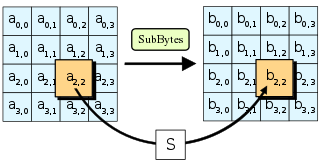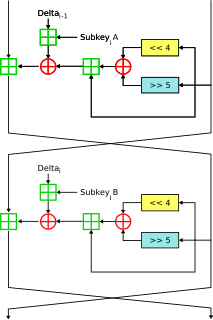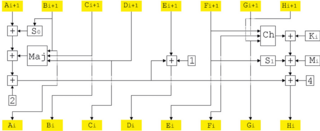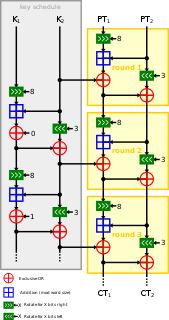Related Research Articles

The Advanced Encryption Standard (AES), also known by its original name Rijndael, is a specification for the encryption of electronic data established by the U.S. National Institute of Standards and Technology (NIST) in 2001.
Blowfish is a symmetric-key block cipher, designed in 1993 by Bruce Schneier and included in many cipher suites and encryption products. Blowfish provides a good encryption rate in software and no effective cryptanalysis of it has been found to date. However, the Advanced Encryption Standard (AES) now receives more attention, and Schneier recommends Twofish for modern applications.
In cryptography, Skipjack is a block cipher—an algorithm for encryption—developed by the U.S. National Security Agency (NSA). Initially classified, it was originally intended for use in the controversial Clipper chip. Subsequently, the algorithm was declassified.

In cryptography, the Tiny Encryption Algorithm (TEA) is a block cipher notable for its simplicity of description and implementation, typically a few lines of code. It was designed by David Wheeler and Roger Needham of the Cambridge Computer Laboratory; it was first presented at the Fast Software Encryption workshop in Leuven in 1994, and first published in the proceedings of that workshop.

In cryptography, XTEA is a block cipher designed to correct weaknesses in TEA. The cipher's designers were David Wheeler and Roger Needham of the Cambridge Computer Laboratory, and the algorithm was presented in an unpublished technical report in 1997. It is not subject to any patents.
In cryptography, Camellia is a symmetric key block cipher with a block size of 128 bits and key sizes of 128, 192 and 256 bits. It was jointly developed by Mitsubishi Electric and NTT of Japan. The cipher has been approved for use by the ISO/IEC, the European Union's NESSIE project and the Japanese CRYPTREC project. The cipher has security levels and processing abilities comparable to the Advanced Encryption Standard.

In cryptography, LOKI97 is a block cipher which was a candidate in the Advanced Encryption Standard competition. It is a member of the LOKI family of ciphers, with earlier instances being LOKI89 and LOKI91. LOKI97 was designed by Lawrie Brown, assisted by Jennifer Seberry and Josef Pieprzyk.
In cryptography, LOKI89 and LOKI91 are symmetric-key block ciphers designed as possible replacements for the Data Encryption Standard (DES). The ciphers were developed based on a body of work analysing DES, and are very similar to DES in structure. The LOKI algorithms were named for Loki, the god of mischief in Norse mythology.

SHACAL-1 is a 160-bit block cipher based on SHA-1, and supports keys from 128-bit to 512-bit. SHACAL-2 is a 256-bit block cipher based upon the larger hash function SHA-256.

In cryptography, the boomerang attack is a method for the cryptanalysis of block ciphers based on differential cryptanalysis. The attack was published in 1999 by David Wagner, who used it to break the COCONUT98 cipher.
In cryptography, impossible differential cryptanalysis is a form of differential cryptanalysis for block ciphers. While ordinary differential cryptanalysis tracks differences that propagate through the cipher with greater than expected probability, impossible differential cryptanalysis exploits differences that are impossible at some intermediate state of the cipher algorithm.
In cryptography, DFC is a symmetric block cipher which was created in 1998 by a group of researchers from École Normale Supérieure, CNRS, and France Télécom and submitted to the AES competition.
In cryptography, a T-function is a bijective mapping that updates every bit of the state in a way that can be described as , or in simple words an update function in which each bit of the state is updated by a linear combination of the same bit and a function of a subset of its less significant bits. If every single less significant bit is included in the update of every bit in the state, such a T-function is called triangular. Thanks to their bijectivity regardless of the used Boolean functions and regardless of the selection of inputs, T-functions are now widely used in cryptography to construct block ciphers, stream ciphers, PRNGs and hash functions. T-functions were first proposed in 2002 by A. Klimov and A. Shamir in their paper "A New Class of Invertible Mappings". Ciphers such as TSC-1, TSC-3, TSC-4, ABC, Mir-1 and VEST are built with different types of T-functions.
In cryptography, Zodiac is a block cipher designed in 2000 by Chang-Hyi Lee for the Korean firm SoftForum.
In cryptography, CIKS-1 is a block cipher designed in 2002 by A.A. Moldovyan and N.A. Moldovyan. Like its predecessor, Spectr-H64, it relies heavily on permutations of bits, so is better suited to implementation in hardware than in software.
In cryptography, Spectr-H64 is a block cipher designed in 2001 by N. D. Goots, A. A. Moldovyan and N. A. Moldovyan. It relies heavily on the permutation of individual bits, so is much better suited to implementation in hardware than in software.

In cryptography, Twofish is a symmetric key block cipher with a block size of 128 bits and key sizes up to 256 bits. It was one of the five finalists of the Advanced Encryption Standard contest, but it was not selected for standardization. Twofish is related to the earlier block cipher Blowfish.
PRESENT is a lightweight block cipher, developed by the Orange Labs (France), Ruhr University Bochum (Germany) and the Technical University of Denmark in 2007. PRESENT is designed by Andrey Bogdanov, Lars R. Knudsen, Gregor Leander, Christof Paar, Axel Poschmann, Matthew J. B. Robshaw, Yannick Seurin, and C. Vikkelsoe. The algorithm is notable for its compact size.

Speck is a family of lightweight block ciphers publicly released by the National Security Agency (NSA) in June 2013. Speck has been optimized for performance in software implementations, while its sister algorithm, Simon, has been optimized for hardware implementations. Speck is an add–rotate–xor (ARX) cipher.

Simon is a family of lightweight block ciphers publicly released by the National Security Agency (NSA) in June 2013. Simon has been optimized for performance in hardware implementations, while its sister algorithm, Speck, has been optimized for software implementations.
References
- Nikolay A. Moldovyan; Peter A. Moldovyanu; Douglas H. Summerville (January 2007). "On Software Implementation of Fast DDP-based Ciphers" (PDF). International Journal of Network Security. 4 (1): 81–89. Archived from the original (PDF) on 2007-09-26. Retrieved 2007-01-12.
- C. Lee; J. Kim; S. Hong; J. Sung; S. Lee (2005). "Related-key differential attacks on Cobra-S128, Cobra-F64a and Cobra-F64b" (PDF). Proceedings of Mycrypt '05, LNCS 3715. Archived from the original (PDF) on 2006-05-07. Retrieved 2007-01-12.
- C. Lee; J. Kim; J. Sung; S. Hong; S. Lee; D. Moon (2005). "Related-key differential attacks on Cobra-H64 and Cobra-H128" (PostScript). Proceedings of IMA Cryptography and Coding '05, LNCS 3796. Retrieved 2007-01-12.
- Jiqiang Lu; Changhoon Lee; Jongsung Kim (2006). "Related-Key Attacks on the Full-Round Cobra-F64a and Cobra-F64b" (PDF). Proceedings of SCN '06 (The Fifth International Conference on Security and Cryptography for Networks), LNCS 4116. Archived from the original (PDF) on 2006-09-25. Retrieved 2007-01-12.